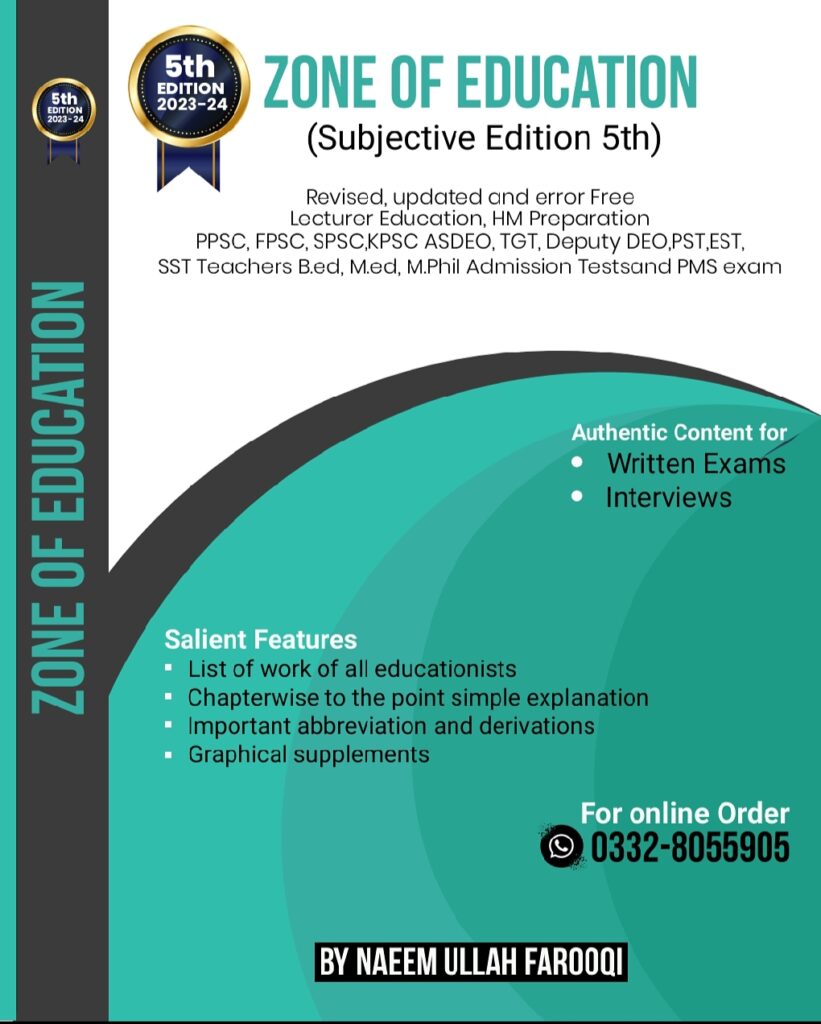Psychology
.71. The concept of intelligence is closely related to:
A. Motivation
B. Learning
C. Perception
D. Cognition
72. Guilford’s structure of intellect model of intelligence is notable because:
A. It separates operations from content and product
B. It rejects the idea of gender feature
C. It yields 180 unique intellectual factors
D. All of these (Ans)
73. Most IQ tests assess:
A. Academic motivation
B. Convergent thinking
C. Perceptual motor skills
D. Creativity (Ans)
74. The most important criterion of whether an individual should be considered retarded is that individual’s:
A. Social competence
B. Mental age
C. IQ (Ans)
D. Ability to learn to speak
75. In general, children who score well on IQ tests have parents who:
A. Pay for tutors and special schools
B. Have very high IQs
C. Punish them if they fail to do well
D. Spend time with them and actively encourage their development (Ans)
76. The prototype of the modern intelligence test for children was developed by:
A. Terman
B. Binet (Ans)
C. Wechsler
D. Stanford
77. According to Maslow, a person with no job, no friends, and no house can be self-actualized:
A. 100 percent yes
B. 100 percent not (Ans)
C. Uncertain
D. None of these
78. Improved job satisfaction results in work performance and turnover:
A. Decrease: decrease
B. Increase: no change
C. Increase: increase (Ans)
D. No change: decrease
79. In Maslow’s theory of personality the main concept is that of:
A. Functional autonomy
B. Acquired drives
C. Interpersonal relations
D. Self-actualization (Ans)
80. According to Maslow’s hierarchy of needs, individuals:
A. May bypass a level in their quest for self-actualization
B. Must satisfy self-esteem needs before achieving belongingness and love needs
C. Always end their lives
D. None of these (Ans)
81. Developmental psychologists believe that two factors that influence human development are:
A. Motivation and emotion
B. Self and others
C. Genetic make-up and experience (Ans)
D. Rewards and punishments
82. The process by which a trained professional uses psychological methods to help people with psychological problems is known as:
A. Psychiatry
B. Psychoanalysis
C. Psychotherapy (Ans)
D. None of these
83. Rational-emotive therapy is a type of:
A. Psychoanalysis
B. Client-centered therapy
C. Cognitive-behavior therapy (Ans)
D. Behavior therapy
84. A therapist who encourages clients to relate their dreams and searches its roots is:
A. Psychoanalysis (Ans)
B. Humanistic therapy
C. Person-centered therapy
D. Cognitive therapy
85. SOLO stands for:
A. Structure of the observable learning outcome
B. Structure of the observing learning outcome
C. Structure of the observed learning outcome (Ans)
D. None of the above
86. SOLO taxonomy consists of levels:
A. 2
B. 3
C. 4
D. 5 (Ans)
87. With reference to SOLO taxonomy, one aspect of a task is understood in:
A. Pre-structural level
B. Multi-structural level
C. Uni-structural level (Ans)
D. None of the above
88. According to SOLO Taxonomy, two or more aspects are understood in:
A. Uni-structural level
B. Multi-structural level (Ans)
C. Open structural level
D. Relational level
89. Integration is developed between two or more aspects in:
A. Logical level
B. Pre-structural level
C. Multi-structural level
D. Relational level (Ans)
Q1: SOLO taxonomy was presented by:
A. Alfred Bandura
B. Kohlberg
C. Biggs & Collis
D. None of the above
Answer: C. Biggs & Collis
Q2: The application of psychological theories, methods, and techniques to solve practical human problems describes an area of psychology known as:
A. Social psychology
B. Para-psychology
C. Applied psychology
D. Humanistic psychology
Answer: C. Applied psychology
Q3: The group in an experiment which receives no treatment is called:
A. Control group
B. Experimental group
C. Working group
D. None of the above
Answer: A. Control group
Q4: A hungry person would find food to be a:
A. Primary reinforcer
B. Secondary reinforcer
C. Positive reinforcer
D. Negative reinforcer
Answer: A. Primary reinforcer
Q5: The combination of responses or ideas in a novel way is called:
A. Exploration
B. Creativity
C. Thinking
D. None of the above
Answer: B. Creativity
![]()
Q6: A feeling of apprehension or tension is:
A. Frustration
B. Panic
C. Anxiety
D. Confusion
Answer: C. Anxiety
Q7: Advertisers place beautiful people or likable places and objects with the products they are trying to sell because these items:
A. Distract from the disadvantages of the products
B. Cause pleasant feelings to be evoked
C. Are part of the products’ basic qualities
D. None of these
Answer: B. Cause pleasant feelings to be evoked
Q8: The suggested cause of abnormal behavior from the cognitive perspective is:
A. Faulty learning
B. Early childhood experiences
C. Unconscious unresolved conflicts
D. Faulty thinking
Answer: D. Faulty thinking
: Headmaster/Headmistress Guideline:
A. Faulty learning
B. Early childhood experiences
C. Unconscious unresolved conflicts
D. Faulty thinking
Answer: B. Early childhood experiences
Q9: Bonuses, recognition awards, praise, and time-off improve motivation through the application of:
A. Performance appraisal
B. Benefits
C. Reinforcement
D. Objective criteria
Answer: C. Reinforcement
Q10: When psychological tests are used in personnel selection, an important concern regarding the tests is:
A. Cost
B. Ease of administration
C. Validity
D. Objectivity
Answer: D. Objectivity
Q11: Thorndike’s “Law of Effect” was an early form of the present-day principle of:
A. Extinction
B. Contiguity
C. Reinforcement
D. Trial and error
Answer: C. Reinforcement
Q12: In operant conditioning:
A. Continuous reinforcement schedule is least susceptible to extinction
B. Negative reinforcement is a type of punishment
C. The process is related to trial and error learning
D. Shaping occurs when responses are coincidentally paired to a reinforcer
Answer: C. The process is related to trial and error learning
Q13: Behaviorism holds that people are conditioned, or trained, to respond in certain ways by:
A. Intelligence
B. Rewards and punishments
C. Appreciation only
D. Punishment only
Answer: B. Rewards and punishments
Q14: The process of learning by watching others is called:
A. Imitative Learning
B. Observational learning
C. Coordinated Learning
D. None of the above
Answer: B. Observational learning
105. The Theory of Observational Learning was introduced by:
· A. Albert Einstein
· B. Albert Napoleon
· C. Albert Bandura
· D. None of the above
Ans: (C) Albert Bandura
JOIN ZONE OF EDUCATIONPK!
Discover the most comprehensive and reliable pedagogy resources in Pakistan, curated for competitive exam success. Our content covers all competitive exam MCQs, including PPSC, FPSC, AJKPSC, SPSC, and more. Designed to empower learners with top-notch material and insights, trust us for your preparation journey!


